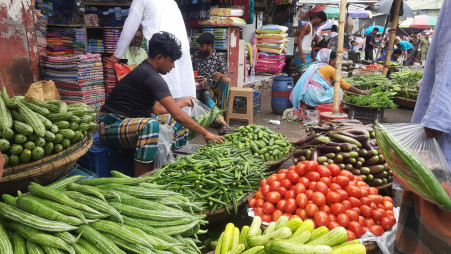Vegetable prices rise 30-40% as heavy October rain disrupts early crops
Vegetables prices were 21-69% cheaper three weeks earlier

Vegetable prices continued to rise unusually in kitchen markets by an average of 30-40% over the past few weeks, instead of declining with the arrival of early winter crops.
Farmers and traders said the increase follows heavy rainfall in late October and early November that damaged vegetable fields. They said the period was crucial for early winter vegetables, and the disruption caused by the rain had a direct impact on supply.
Farmers usually cultivate winter vegetables during September-October, while some begin as early as August for early harvests. As a result, early winter vegetables normally enter markets in full volume from the first week of November.
This year, however, October saw 35% more rainfall than usual. Growers in northern districts faced four consecutive days of heavy rain between 30 October and 2 November, which agriculture officials said caused significant losses to early-season crops.
Dhaka markets see sharp price spikes
On visits to Shahjadpur, Karwan Bazar, Badda, and Hatirpool markets today (20 November), it was observed that key vegetables were selling at considerably higher prices.
Yardlong beans were selling for Tk100-120 a kg, bitter gourd for Tk80-120, okra for Tk70-80, pointed gourd for Tk60-80, bottle gourd for Tk50-80, long beans for Tk80-100, snake gourd for Tk60-80, and eggplant for Tk60-120.
Prices of essential items were also elevated, with green chilli selling for Tk140-200, old potatoes for Tk24-30, onions for Tk100-115, and green papaya for Tk25-40 a kg.
Prices were not this high before the rainfall. On 29 October, yardlong beans were sold for Tk50-80, bitter gourd and eggplant for Tk40-80, long beans for Tk50-80, and pointed gourd for Tk35-80. This means these vegetables were 21-69% cheaper just three weeks earlier.
Shahid Mia, a shopper at Hatirpool, said, "There is supposedly a supply crisis, but the market has everything. Prices are being set however traders want. If this continues, people will barely be able to afford vegetables."
Traders cite reduced supply across major hubs
Hannan, a trader at Karwan Bazar, said the regions that typically supply winter vegetables were hit hardest by the heavy rain, which damaged cultivation.
"Right now, they are unable to send enough produce. Supply from other areas will start improving from early December, and prices may ease once larger quantities arrive," he said.
Hatirpool trader Monir Hossain said markets are not receiving enough produce from production hubs. "The limited supply, he said, is not sufficient to meet daily demand."
According to the Department of Agricultural Extension (DAE), the cultivation target for vegetables in the current Rabi season is 6.35 thousand hectares. So far, planting has taken place on only 1.49 thousand hectares.
Farmers report reduced yields
At the Dupchanchia market in Bogura today, farmer Azahar Ali was selling pointed gourd for Tk70 a kg and eggplant for Tk100 a kg.
He said the impact of unseasonal rainfall has been severe. "The rain damaged both pointed gourd and eggplant badly, and the output is less than half."
Alauddin Mondol, a farmer from Naogaon, said he had cultivated cauliflower on 10 katha but received less than half the usual yield. "The same is happening with other vegetables."
Experts blame heavy rain for driving disease, cutting output
Abu Noman Faruq Ahmmed, plant pathology professor at Sher-e-Bangla Agricultural University told TBS that prolonged wet conditions increased disease infestation, reducing plant productivity further.
"As production drops, farmers have to sell at higher prices to recover costs. Many growers avoided early planting because of the rain. Overall, the season has been pushed back, and that is why prices in the market are higher," he said.
Additional reporting by our Bogura Correspondent Khorshed Alam



 Keep updated, follow The Business Standard's Google news channel
Keep updated, follow The Business Standard's Google news channel
















